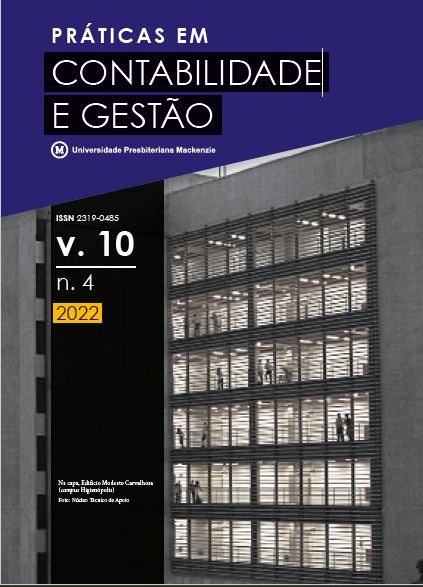USE OF DIGITAL NUDGE TOOL FOR THE SUPPLY CHAIN PROCESS
Relato Tecnológico
Keywords:
Arquitetura de decisão, Nudges, Ocupação de veículosAbstract
The objective of this study is to promote an intervention in a vehicle loading process in a multinational company operating in the business of selling roasted and ground coffees, this intervention aims to increase the occupancy of loaded vehicles through an application totally based on the concepts of decision architecture and nudges. In addition to the intervention, the objective of the research was to assess whether, in the perception of the main parties involved, the proposal would be effective in increasing the occupancy of vehicle trunks, as a result it was identified that there is a perception of aid to improve performance, but in addition, that the application of the tool meets the criteria of the nudge concept, assuming that it will be an influence, not a systemic imposition.
Downloads
References
Berger, M., Greinacher, E., & Wolf, L. (2022). Digital Nudging to Promote Energy Conservation Behavior: Framing and Default Rules in a Smart Home App.
Beshears, J., & Kosowsky, H. (2020). Nudging: Progress to date and future directions. Organizational behavior and human decision processes, 161, 3-19.
Creswell, J. W. (2007). Projeto de Pesquisa: método qualitativo, quantitativo e misto (2 ed.). Porto Alegre: Bookman.
Creswell, J. W. (2014). Investigação Qualitativa e Projeto de Pesquisa: Escolhendo entre Cinco Abordagens (3 ed.): Penso.
Dresch, A., Lacerda, D. P., & Antunes, J. A. V. J. (2014). Design Science Research: Método de Pesquisa para Avanço da Ciência e Tecnologia. Porto Alegre: Bookman.
Dubé, L., & Paré, G. (2003). Rigor in information systems positivist case research: Current practices, trends, and recommendations. MIS Quarterly: Management Information Systems, 27(4), 597-635. doi:10.2307/30036550
Fisher, I. (1930). Theory of interest: as determined by impatience to spend income and opportunity to invest it: Augustusm Kelly Publishers, Clifton.
Goswami, I., & Urminsky, O. (2016). When should the ask be a nudge? The effect of default amounts on charitable donations. Journal of Marketing Research, 53(5), 829-846.
Gregor, S., & Lee‐Archer, B. (2016). The digital nudge in social security administration. International Social Security Review, 69(3-4), 63-83.
Haki, K., Rieder, A., Buchmann, L., & W. Schneider, A. (2022). Digital nudging for technical debt management at Credit Suisse. European Journal of Information Systems, 1-17.
Hansen, P. G. (2016). The definition of nudge and libertarian paternalism: Does the hand fit the glove? European Journal of Risk Regulation, 7(1), 155-174.
Johnson, E. J., Shu, S. B., Dellaert, B. G., Fox, C., Goldstein, D. G., Häubl, G., . . . Schkade, D. (2012). Beyond nudges: Tools of a choice architecture. Marketing letters, 23(2), 487-504.
Keynes, J. M. (1936). The General Theory of Employment, Interest, and Money. London: Macmillan.
Lambert, D. M., & Burduroglu, R. (2000). Measuring and Selling the Value of Logistics. The International Journal of Logistics Management, 11(1), 1-18. doi:10.1108/09574090010806038
Manson, N. (2006). Is operations research really research? ORiON, 22, 155-180. doi:10.5784/22-2-40
Marconi, M. d. A., & Lokatos, E. M. (2017). Metodologia Científica (7 ed.). São Paulo: Atlas.
Mertens, S., Herberz, M., Hahnel, U. J. J., & Brosch, T. (2022). The effectiveness of nudging: A meta-analysis of choice architecture interventions across behavioral domains. Proceedings of the National Academy of Sciences, 119(1), e2107346118. doi:10.1073/pnas.2107346118
Mingers, J., & Walsham, G. (2010). Toward ethical information systems: The contribution of discourse ethics. Mis Quarterly, 833-854.
Mirsch, T., Lehrer, C., & Jung, R. (2018). Making digital nudging applicable: The digital nudge design method. Paper presented at the Proceedings of the 39th international conference on information systems (ICIS).
Rodriguez, J., Piccoli, G., & Bartosiak, M. (2019). Nudging the classroom: Designing a socio-technical artifact to reduce academic procrastination. Paper presented at the Proceedings of the 52nd Hawaii International Conference on System Sciences.
Sahin, O., Cetin, M., & Ustun, I. (2021). Detecting empty and loaded platform semi-trailers using side-fire LiDAR data for supporting freight analysis. Case Studies on Transport Policy, 9(3), 1035-1041. doi:https://doi.org/10.1016/j.cstp.2021.05.006
Sun, X., Li, X., Xiao, D., Chen, Y., & Wang, B. (2021). A Method of Mining Truck Loading Volume Detection Based on Deep Learning and Image Recognition. Sensors (Basel), 21(2). doi:10.3390/s21020635
Sunstein, C. R. (2014). Nudging: a very short guide. Journal of Consumer Policy, 37(4), 583-588.
Thaler, R. H. (2016). Behavioral economics: Past, present, and future. American economic review, 106(7), 1577-1600.
Thaler, R. H., & Sunstein, C. R. (2009). Nudge: Improving decisions about health, wealth, and happiness: Penguin.
Tobias, M., Lehrer, C., & Jung, R. (2018). Making Digital Nudging Applicable: The Digital Nudge Design Method. Paper presented at the Thirty Ninth International Conference on Information Systems, San Francisco.
Tversky, A., & Kahneman, D. (1980). The framing of decisions and the rationality of choice. Retrieved from
Van Aken, J. (2005). Management Research as a Design Science: Articulating the Research Products of Mode 2 Knowledge Production in Management. British Journal of Management, 16, 19-36. doi:10.1111/j.1467-8551.2005.00437.x
Wansink, B., Kent, R. J., & Hoch, S. J. (1998). An anchoring and adjustment model of purchase quantity decisions. Journal of Marketing Research, 35(1), 71-81.
Weiner, B. J. (2009). A theory of organizational readiness for change. Implementation Science, 4(1), 67. doi:10.1186/1748-5908-4-67
Weinmann, M., Schneider, C., & Brocke, J. v. (2016). Digital nudging. Business & Information Systems Engineering, 58(6), 433-436.
Willermark, S., & Islind, A. S. (2022). Choice architecture, friend, or foe? Future designers’ perspective on the ethics of digital nudges. Paper presented at the 13th Scandinavian Conference on Information Systems (SCIS), Helsinge, Denmark, 2022.
Yin, K. R. (2014). Estudo de caso: Planejamento e Métodos (5 ed.): Bookman.
YIN, R. K. (2015). Estudo de caso: planejamento e métodos. Porto Alegre: Bookman.
Downloads
Published
How to Cite
Issue
Section
License
Copyright (c) 2023 Alexandre Nunes Hernandes, Evandro Henrique Ferreira Scussel, Marcio Quadros Lopes dos Santos, Sérgio Apolinário

This work is licensed under a Creative Commons Attribution 4.0 International License.
Os direitos autorais dos artigos publicados na Práticas em Contabilidade e Gestão pertencem aos autores, que concedem à Universidade Presbiteriana Mackenzie os direitos de publicação do conteúdo. Após a aprovação do artigo, os autores concedem à revista o direito da primeira publicação.



